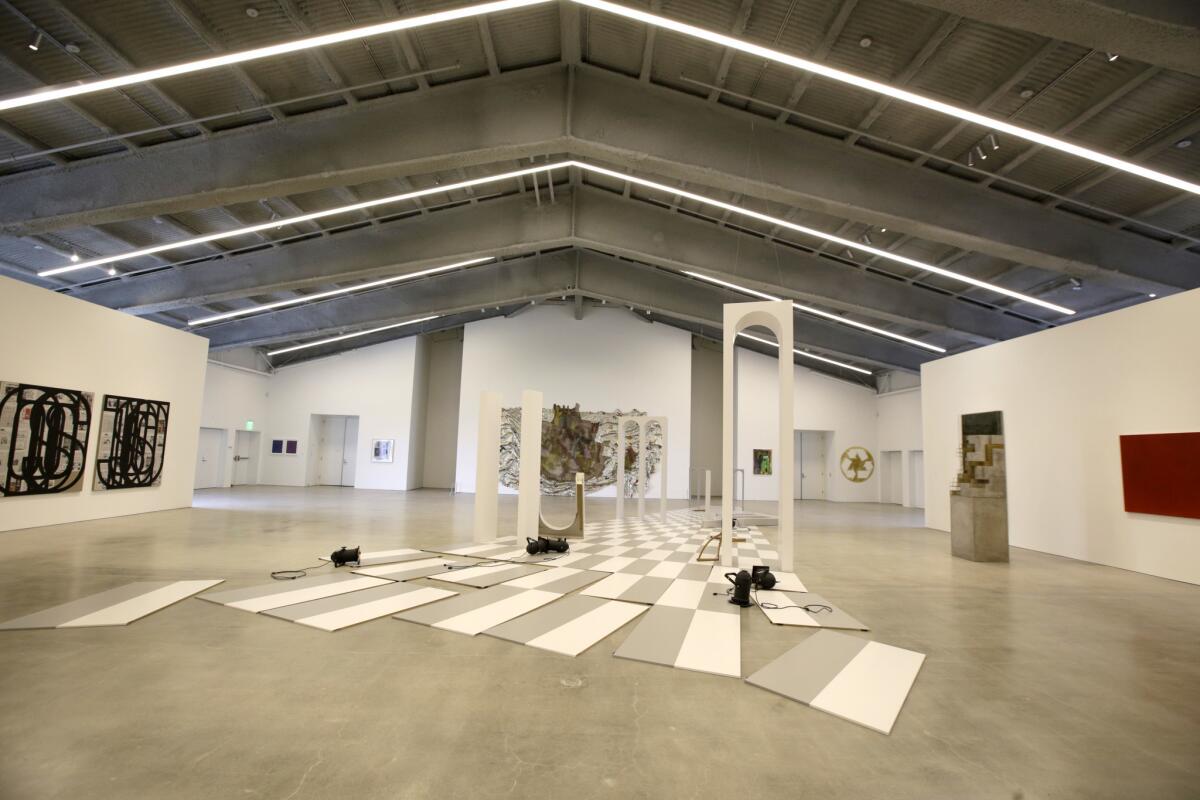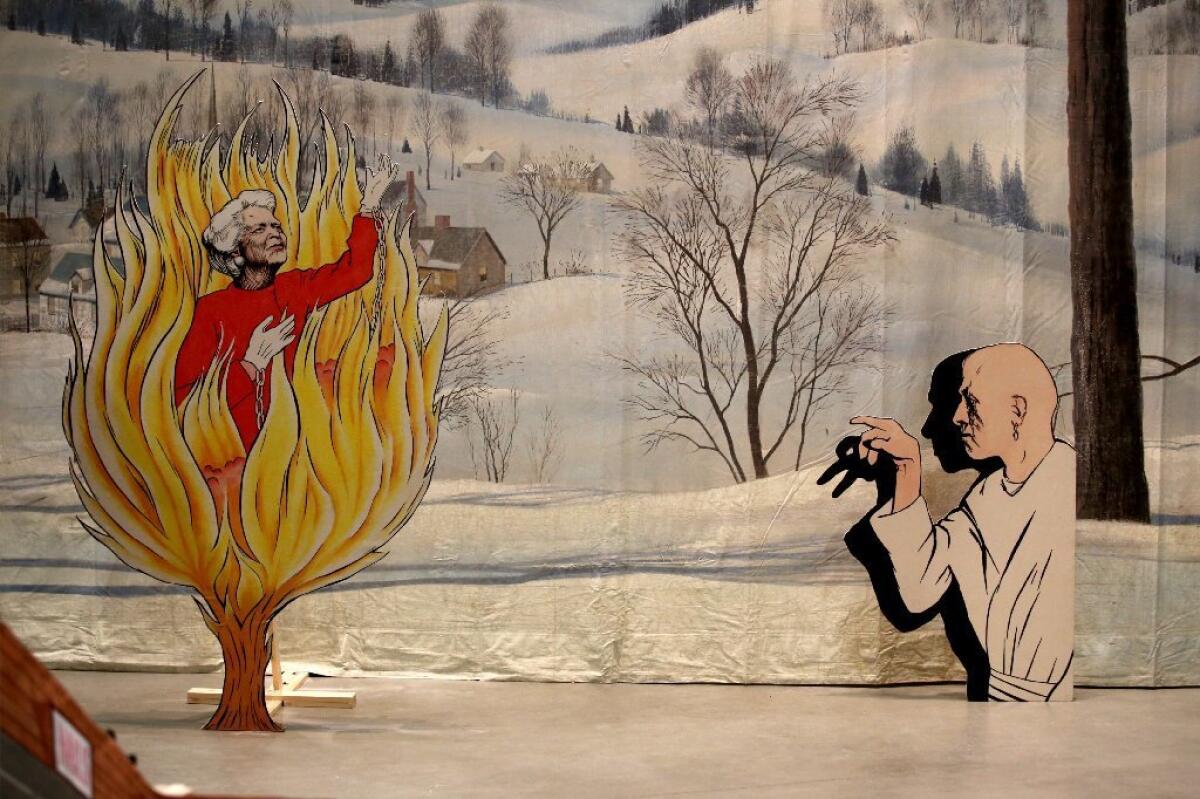Review: New Marciano foundation proves the potential and the pitfalls of a vanity art museum

The Marciano Art Museum is opening a landmark L.A. building to the public for the first time. (May 24, 2017) (Sign up for our free video newsletter here)
- Share via
Once upon a time, major collectors who wanted to share the art they had acquired and loved would eventually donate it to a trusted institution. Attention and care for posterity were assured.
Those days are on the wane, especially for contemporary art. Now, rather than give their art to a museum, many collectors are opening their own.
This week the Marciano Art Foundation joins the throng, opening to the public on Thursday in the long-shuttered, handsomely refurbished Scottish Rite Masonic Temple on Wilshire Boulevard. (Architect Kulapat Yantrasast did the renovation honors.) It’s a big, boxy barn of a building, decorated in travertine, gilding and mosaics. Brothers Paul and Maurice Marciano, founders (with siblings Georges and Armand) of Guess Jeans, have carved out galleries to show selections from their 1,500-piece collection.
Plus, there’s abundant space for monumental special exhibitions. Jim Shaw’s epic installation, “The Wig Museum,” is first out of that gate. The show is a winner, the collection more iffy.
Vanity museums aren’t new. Locally, see Huntington, Getty, Hammer and Broad; or, in New York, Whitney, Guggenheim, Rubin and Lauder.
But their numbers have jumped, coinciding with the new concentration of individual wealth. Credit (or blame?) goes to the millennium boom in billionaires.


According to a recent report in Inside Philanthropy, 80% of single-family museums have been created in the 21st century. The advantage goes to the collector, who gets a nonprofit tax benefit while retaining private control of the collection.
The disadvantage is to the public. Private collectors are rarely good judges of the larger scholarly contexts in which art, especially very recent art, is best seen. The Marciano Foundation would benefit from some deeply informed professional guidance.
There is also a twist. Maurice Marciano, the more active art enthusiast (Paul still runs the company), is co-chairman of the board at the Museum of Contemporary Art. He’s been very generous in that role, ranking among
Like similar projects in California, Florida, Texas, Connecticut, Maryland and elsewhere, the Marciano Art Foundation isn’t exactly a museum. It’s merely a private collection open to the public.
The selection is highly personal. The mission statement is freewheeling (“Through exhibiting a diverse and compelling collection … MAF aims to encourage curiosity and contemplation of art.”) The professional staff is limited, as are public hours (Thursday through Saturday and only with reservations, which are free but already booked through June).
A walk through the galleries has something of the feel of an art fair, where random juxtapositions meet a few more organized combinations. More than 90% of the art in the debut presentation was made in just the last 10 years. The art is too new to have settled yet into historical frameworks and culturally revealing patterns. The galleries are at once jumbled and tame.
The inaugural selection, “Unpacking: The Marciano Collection” (through Dec. 24) presents about 114 works by 47 artists — 32 men and 15 women. The gender disparity reflects the collection’s market orientation, where male artists dominate. The works were chosen from more than 1,500 paintings, sculptures, drawings, photographs, videos, prints and installations by more than 200 international artists.
Mike Kelley, Sherrie Levine, Sterling Ruby, Mark Grotjahn, Albert Oehlen, Takashi Murakami, Louise Lawler, Christopher Wool, El Anatsui — a lot of the artists overlap with those at the Broad, L.A.’s other new vanity museum. (Marciano focuses on artists who have emerged since the 1990s, while Broad includes artists since the 1950s.) Virtually all are well-known through international exhibitions and influential galleries; few will be discoveries, except to a general public.
Philipp Kaiser, former director of Germany’s Ludwig Museum and former MOCA curator, was enlisted as guest curator for the inaugural exhibition. He’s done a credible job of giving some shape, however loose, to a finally unruly selection. Kaiser has grouped works according to their evident interest in history or in the process of the art’s making.
Sometimes the two overlap — inevitably, since process art is a product of the 1960s, which means it has its own long history. Wade Guyton, for example, uses new digital technology to revive old abstract painting.
His large canvases are “painted” by running linen through big inkjet printers and flatbed scanners, not by applying pigment-loaded paintbrushes. The big “X” compositions, programmed with

Other installations juxtapose pairs of artists whose work is at least lightly connected.
Oehlen’s big, vaporous, suavely gestural canvases and Wool’s big, bluntly stenciled word-paintings use very different means to similar ends: Traditional artistic modes of expressive communication are interrupted.
Kelley’s bell-jar sculptures of Superman’s lost outer-space hometown of Kandor radiate a punk outsider-ethos, which is likewise essential to understanding the gritty abstract paintings by Sterling Ruby that double as pictures of poisonous sunsets. Ruby was once Kelley’s student and studio assistant.
A few artists are under 40. The standout is Analia Saban, who makes inventive use of traditional materials.
In one sculpture, a shattered slab of pinkish marble held together by wire mesh is draped like soft fabric over a wooden sawhorse, as if workroom laundry hung out to dry. Making a rigid material unexpectedly malleable, she evokes an ancient history of fluid sculptural drapery dating at least to the swirling, 2nd century B.C. chiton worn by the “Winged Victory of Samothrace.”
Ruby, Kelley, Guyton, Wool, Murakami, Grotjahn and Glenn Ligon are shown in some depth, with five or more examples each. Individual quality is uneven. The earliest work — a collection anomaly since it dates from 1989 — is a large selection of unique photographs from Kelley’s wonderfully cheeky “Reconstructed History” series.
Kelley defaced schoolroom textbook pictures on American history in lewd and scatological ways, like an immature junior high brat. (The late artist was anything but.) These vandalized images, produced amid the wreckage left behind by the Reagan administration’s imposition of injurious social policies, are outrageous affronts to Founding Fathers, the Statue of Liberty and other sentimentalized national symbols of democracy.
A seriocomic assault on household maxims of American exceptionalism in an era of steep decline, the series eloquently introduces “The Wig Museum,” the huge installation by Shaw, Kelley’s friend and colleague. The special exhibition (through Sept. 17) was also organized by Kaiser. One inspiration was the secret-society pageantry of Freemasonry.


Shaw has filled the vast space that was once the Masonic Temple’s 2,000-seat theater with sculptures, drawings, video projections and found theatrical backdrops, several of which he has over-painted and dramatically illuminated in colored lights. It’s a surreal fun house, where cultish Anglo-Saxon rituals dating to America’s 18th century origins mix with a vortex of commercial culture to create a nightmarish hell-scape.
In one area, Satan plunges sinners into a lake of fire as a nearby Electrolux vacuum cleaner sucks up translucent souls. The vacuum’s phallic hose protrudes from the loins of George Washington, hovering in a cloud above.
His image is adapted from Horatio Greenough’s famous 1832 sculpture of “Enthroned Washington,” itself based on Phidias’ great Greek statue of Zeus Olympios, one of the Ancient World’s Seven Wonders. Below, a patrician Barbara Bush is engulfed in flames before a frozen winter landscape — a “burning bush” watched over by Aleister Crowley, the aristocratic English occultist, libertine and counter-culture prophet.
And that’s only for starters. Shaw is just getting warmed up.
Nearby, Steve Jobs inserts an iPhone directly into the brain of supervillain Lex Luthor, power-mad American businessman and philanthropist. The installation piles strange atop outlandish.
We had an early hint: Shaw’s dizzying phantasmagoria of American manners and mores opens with a stylish Hollywood Regency museum of wigs. Some were salvaged from the Masonic Temple’s storage rooms of pageant costumes, some are historical re-creations (such as an Egyptian helmet-style wig) and others — the artist’s florid inventions — would make RuPaul swoon.
It’s hard not to see the mad Wig Museum as also the Whig Museum — a feverish nod to the pre-Civil War political party born in opposition to the brutal policies of President Andrew Jackson, hero to
In fact, “The Wig Museum” and its agitated burlesque of chaos and collapse couldn’t be timelier. A sign of what could become the Marciano Foundation’s most important function, the special exhibition is the primary reason, beyond routine curiosity, to visit the glossy new venue.
♦ ♦ ♦ ♦ ♦ ♦ ♦ ♦ ♦ ♦
Marciano Art Foundation
Where: 4357 Wilshire Blvd., L.A.
When: Thursday and Friday, 11 a.m.-5 p.m.; Saturday, 10 a.m.-6 p.m.
Admission: Free (timed reservations required)
Information: marcianoartfoundation.org
Twitter: @KnightLAT
ALSO
The architecture review: Marciano trades vintage eccentricity for contemporary style
The profile: Kulapat Yantrasast, the architect behind the Marciano Art Foundation
The scene: The Marciano’s opening gala
The sneak peek: Inside the Marciano Art Foundation before it opens
The biggest entertainment stories
Get our big stories about Hollywood, film, television, music, arts, culture and more right in your inbox as soon as they publish.
You may occasionally receive promotional content from the Los Angeles Times.








